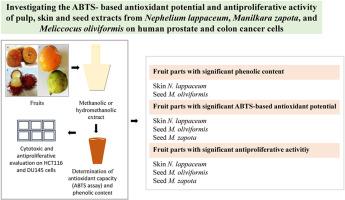Investigating the ABTS-based antioxidant potential and antiproliferative activity of pulp, skin and seeds extracts from Nephelium lappaceum, Manilkara zapota, and Meliccocus oliviformis on human prostate and colon cancer cells
IF 2.2
Q3 BIOCHEMISTRY & MOLECULAR BIOLOGY
引用次数: 0
Abstract
Despite significant advancements in cancer treatments, cancer remains the second leading cause of death worldwide, creating a pressing need for effective and non-toxic therapies. Plant bioactive compounds, particularly phenolic acids, have shown promising antioxidant and anticancer properties. In this study, we investigated the antioxidant potential and antiproliferative activity of methanolic extracts obtained from the skin, pulp, and seeds of three exotic fruits commonly consumed in Mexico: Manilkara zapota, Nephelium lappaceum, and Meliccocus oliviformis. The antioxidant activity was assessed using the ABTS radical scavenging assay, and total phenolic content was quantified by a modified Folin-Ciocalteu method. Most extracts exhibited significant ABTS radical scavenging capacity, with the highest phenolic content detected in the skin and seeds of N. lappaceum.
and M. oliviformis. Cytotoxic and antiproliferative effects were evaluated on human colon (HCT116) and prostate (DU145) cancer cell lines. The skin of N. lappaceum and the seeds of M. zapota and M. oliviformis showed strong antiproliferative activity. These findings highlight the therapeutic potential of underutilized fruit by-products and support further investigation into their bioactive constituents as complementary candidates for cancer treatment.

研究了枸杞、芒果树和橄榄木的果肉、皮和种子提取物对人前列腺癌和结肠癌细胞的抗氧化活性和抗增殖活性
尽管癌症治疗取得了重大进展,但癌症仍然是全球第二大死亡原因,因此迫切需要有效和无毒的治疗方法。植物生物活性化合物,特别是酚酸,已显示出良好的抗氧化和抗癌特性。在这项研究中,我们研究了从墨西哥常见的三种外来水果(Manilkara zapota, Nephelium lappaceum和Meliccocus oliviformis)的皮、果肉和种子中提取的甲醇提取物的抗氧化潜力和抗增殖活性。采用ABTS自由基清除法测定其抗氧化活性,采用改良的Folin-Ciocalteu法测定其总酚含量。大部分提取物具有明显的ABTS自由基清除能力,其中皮和种子中酚含量最高。和橄榄状分枝杆菌。对人结肠癌(HCT116)和前列腺(DU145)癌细胞株进行了细胞毒和抗增殖作用评价。野田鼠皮、野田鼠种子和野田鼠种子均表现出较强的抗增殖活性。这些发现突出了未充分利用的水果副产品的治疗潜力,并支持进一步研究其生物活性成分作为癌症治疗的补充候选物。
本文章由计算机程序翻译,如有差异,请以英文原文为准。
求助全文
约1分钟内获得全文
求助全文
来源期刊

Biochemistry and Biophysics Reports
Biochemistry, Genetics and Molecular Biology-Biophysics
CiteScore
4.60
自引率
0.00%
发文量
191
审稿时长
59 days
期刊介绍:
Open access, online only, peer-reviewed international journal in the Life Sciences, established in 2014 Biochemistry and Biophysics Reports (BB Reports) publishes original research in all aspects of Biochemistry, Biophysics and related areas like Molecular and Cell Biology. BB Reports welcomes solid though more preliminary, descriptive and small scale results if they have the potential to stimulate and/or contribute to future research, leading to new insights or hypothesis. Primary criteria for acceptance is that the work is original, scientifically and technically sound and provides valuable knowledge to life sciences research. We strongly believe all results deserve to be published and documented for the advancement of science. BB Reports specifically appreciates receiving reports on: Negative results, Replication studies, Reanalysis of previous datasets.
 求助内容:
求助内容: 应助结果提醒方式:
应助结果提醒方式:


